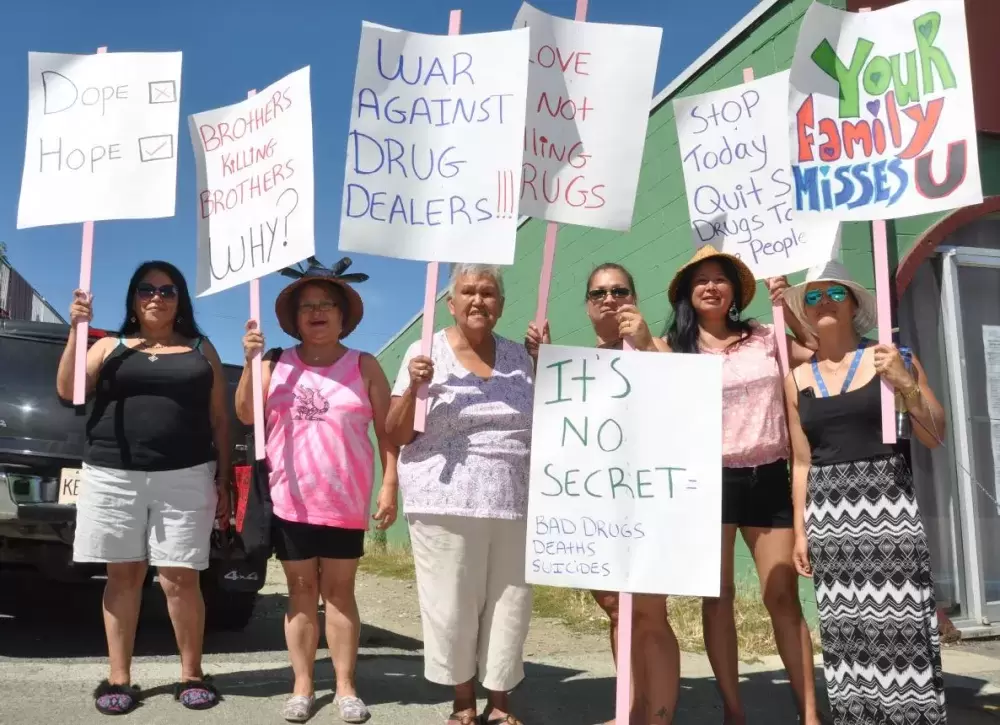Following a major drug seizure and a rash of local overdose deaths, two Nuu-chah-nulth women decided to take action, setting up a street protest outside apartments on Third Avenue.
Co-organizer Gail K. Gus said the goal of the protest was to confront the drug dealers and the drug users who are making the streets so dangerous.
“We’re scared. We want our families back and we’re scared were going to bury more people,” Gus said.
“We’re trying to bring awareness and hoping that the people we know who are drug dealers will find a conscience.”
Gus noted that the dealers and the users are known and visible. While the protest proceeded, the owner of the apartments made several appearances, several times berating the protesters.
“It’s unsafe and it’s scary,” Gus said. “My big thing is that I don’t want to bury any more young people. I know a young girl who passed away recently from an overdose; I have grandchildren, and I worry they’re next.”
Veronica Phillips had a ready reply for why she was protesting.
“The death of Jocelyn George. She was just a child. Nobody should have given her the stuff they were giving her. She didn’t know what to do with it and they just left her to die.”
Prior to changing owners and undergoing renovations, the apartment was better known as the legendary Frigstad Apartments. Phillips said the long history of drug trafficking is particularly aggravating.
“If it’s legendary, why is it still here?”
The protest took place on the fourth Wednesday of July: Welfare Wednesday, when welfare and other government support cheques are issued. Gus noted that in the electronic age, Welfare Wednesday starts at the stroke of midnight.
“I drove around here after midnight last night, just after the cheques came out,” she said.
There were already lineups at the automated bank machines, with people withdrawing their money and heading straight to the drug houses.
“It was like mid-day out here.”
As the protest gathered members, passers-by honked to show their support. Uchucklesaht elected Chief Councillor Charlie Cootes Sr. stopped to commend the protestors and to get an update on some of the latest street action.
Cootes declined to comment for Ha-Shilth-Sa, saying he would leave it to the people who were taking action. Later, Nuu-chah-nulth Tribal Council vice-president Ken Watts arrived to offer some quiet support.
One neighbor who came to offer both moral support and cold drinks was Aaron Brevick.
“I operate a [Third Avenue] marijuana dispensary, and we have closed for the day, out of respect for what they are doing. We just want to support them,” Brevick said, adding that he suffered his own drug-related family nightmare.
“My sister died from prescription medication – an overdose of pharmaceuticals that a doctor prescribed,” he said.
“I consider pharmaceuticals to be heavy drugs. She was four-foot-eleven and 98 pounds, and she was given the same prescription a 300-pound trucker gets. And after a month, she just didn’t wake up.”
Brevick said it was “crazy” that people had to take to the streets to demonstrate their anger over the open trafficking of potentially lethal drugs. “Out of sight and out of mind” should not apply in the area of heavy narcotics, he noted.
As part of the protest, Gus and her supporters unfurled a long banner with a canoe image, to represent a chaputz, where the names of the dead are written. Rita Watts added one name. Her anger was still palpable after two years.
“I lost my brother John. He left this building. He went home and he hanged himself. His name was John Watts.”
Gus said the protest came together after conferring with a good friend, Lea Rothery, who had her own names to add to the chaputz (Carmen and Roberta).
“I just put it out on Facebook this morning, and hopefully, people will join us,” Gus said, adding that she intended to maintain a presence through the day.
“It’s an uncomfortable time,” she said, noting the presence of several known drug dealers. “Hopefully, we’re making them uncomfortable.”
The protest took place the same day the province announced the formation of a Joint Task Force on Overdose Response.
Provincial health officer, Dr. Perry Kendall, who declared a public health emergency in April, will head the task force with director of police services Clayton Pecknold.
The task force has a number of objectives, ranging from creating more safe injection sites, street testing for drugs and distribution of naloxone kits, which are used to treat overdose victims, as well as enforcement measures to prevent the manufacture and distribution of street drugs, particularly fentanyl.







